A Fresh Perspective to Grassroots Music Advocacy in Your Community
Olivia Ellis, NCTM
MTNA Business Digest
Volume 4, Issue 3
April 2025
The Sound of Change
Imagine a world where everyone has the opportunity to learn an instrument, raise their voice in song and explore their creativity through music. Grassroots music advocacy is making that vision a reality—one community at a time. It connects people through music and strives to ensure that every child, no matter their background, has access to the transformative power of music education.
As music educators, many of us are familiar with the vast benefits of participating in music. For example, children who study music have enhanced cognitive development and better language skills (Tierney, Krizman and Kraus 2015, 10062–10067), and they often score higher on standardized tests (Johnson and Memmott 2006, 293). Music helps children work on discipline and focus, and it even nurtures resilience and confidence to work through challenges (Gustafson 2017, 108). On the social level, music students develop collaborative skills and emotional intelligence, qualities that are greatly coveted by employers (Hudziak et al. 2014, 1152–1161).
The list of benefits can seem endless, and yet, music is often required to justify its existence to those who may have very little or no understanding of it. How can we ensure music is seen not just as an extracurricular activity but as a vital, life-changing force?
Since music teachers are some of the best advocates for the arts, we must connect with and educate decision makers and others with influence. Yet sometimes, presenting the information, as compelling as it may be, is not enough. People need to see and experience the power of music. This is where grassroots music advocacy can bridge the divide; investing our time and energy into promoting music within our local communities can make a long-lasting impact.
At the community level, music holds a special place in the heart of culture and can connect people across generations, socioeconomic statuses and backgrounds. Building advocacy in our local cities and towns is an investment with far-reaching effects for everyone involved. However, sometimes it can feel daunting to try something new, and the programs currently happening may not be as effective as in the past. Included here are some fresh ideas for implementing initiatives with an angle toward music advocacy at the local level.
From Notes to Action: Making Advocacy Happen
The first step toward effective advocacy is to move beyond the idea that it is a solo project. Music advocacy works best when it is a collaborative, community-driven experience. Many of the following suggestions are easier to implement when working together, so it is recommended to collaborate whenever possible. MTNA members can work with other teachers in their local association, nearby teacher groups and various community groups to pool resources, including one of the most valuable resources: the time investment of those involved.
1. Plan Performances for the Community
When organizing events, think beyond your studio or school’s clientele. A performance isn’t truly a community event unless the entire community is invited to participate, not just our students and their families. Ensure outreach efforts are inclusive and actively invite people outside the studio circle. To make the event convenient and approachable, consider locations such as bookstores, coffee shops, local parks and even libraries. Also, consider expanding the genres your students play at events, making sure to program the students’ best and most engaging repertoire. On many occasions, I have had students play music to go along with children’s stories, which we narrate at a place like the public library; kids from the community who wouldn’t normally attend, and their parents, have shown up for events like these.
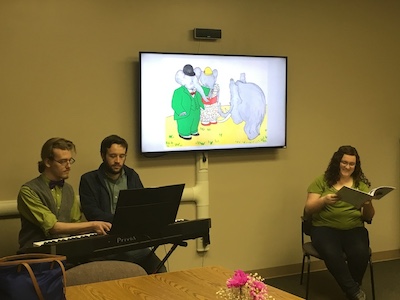
Some studios have scheduled performances in malls and shopping centers, providing a casual way for passing shoppers to enjoy music. Depending on your location, advertising a free performance in a mall can draw some unexpected listeners and also promote your studio. On a recent trip to Hawaii, we heard about a hula show at a local mall; since it was an area we were already visiting, we decided to drop by and were shocked to find more than 200 people enjoying the show! Get creative and get the word out—you never know who will come.
You might consider plugging into celebrations that already take place. For example, once a year, people around the world use street parking spaces as places for music and art. “Park(ing) Day” provides a rich opportunity to bring music to a different part of your community. Music teachers could line up and schedule performances to fill an afternoon. Chattanooga Music Teacher Association member Buddy Shirk shared these photos of Park(ing) Day in downtown Chattanooga, Tennessee.
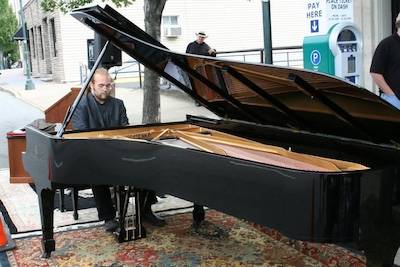
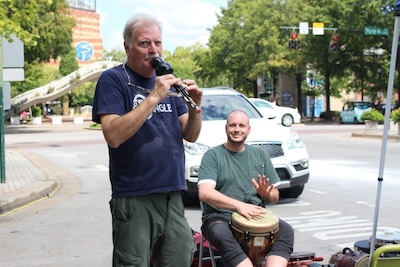
You can even combine a community performance with an outreach project. For example, hospitals often need volunteers to play piano for family members waiting in lobbies. Whenever I have done this, I always have many friendly listeners come up to ask questions and inquire about the music in between selections. Not only is the music reaching more people, but it also becomes meaningful for the performer.
2. Improve Accessibility
One of the essential goals of music advocacy is ensuring music education is accessible to all, regardless of background or financial means. At the community level, you can coordinate with local businesses or partners to provide opportunities to underprivileged students and those who cannot afford lessons. Many local associations also fundraise to establish scholarships for deserving students. Whether through donations or working with nonprofits like the MusicLink Foundation, scholarships provide an opportunity for students who may not otherwise have access to a music foundation.
Although it may not be possible in every situation, you might decide to teach a few students on a volunteer basis. Check for ways to get involved in your area, as there may already be programs set up to teach students in need. For example, in Knoxville, Tennessee, the Joy of Music School accepts donations and works with volunteers to provide free music education for disadvantaged, at-risk youth. In Oklahoma City, Oklahoma, Positive Tomorrows sponsors a program for families experiencing homelessness. They offer their piano lessons as a group class, which allows for a broader reach of students while maintaining quality instruction.
Beyond lessons, music students need instruments, equipment and sheet music. Community members sometimes have these items sitting at home unused, and they may be willing to donate. An instrument donation drive is both good for the planet and good for students in the community! It also brings even more awareness to music needs and gives residents an opportunity to support local music, perhaps even with a tax write-off. You could include these donors in future newsletters about upcoming events and advocacy news, building even deeper connections.
3. Integrate Music with Other Disciplines
Another creative way to advocate for music is to show how it intersects with other fields and disciplines. Music can be a powerful tool for learning across many subjects! If your K–12 school has a significant focus on STEM, it may be helpful to demonstrate how music can improve a student’s experience with those subjects.
For example, studies have shown that musical training enhances mathematical and spatial reasoning skills (Guhn et al. 2020, 308–328). If you are in a school setting, you could work with math colleagues to integrate rhythm exercises to teach fractions. Or, collaborate with a history colleague to turn historical events into music lessons by creating songs about important facts. Do you remember this video—“I’m Just a Bill”—about turning a bill into a law from the School House Rock series? You can use the same principle with any school lesson.
Beyond collaboration, create awareness campaigns that show how music literacy can support learning in all subjects. Eye-catching advertisements like t-shirts or posters can make a bold statement and showcase your theme. MTNA member Sarah Strickland, from Strickland Suzuki Strings in Indiana, proudly wears this shirt to raise awareness of music literacy.
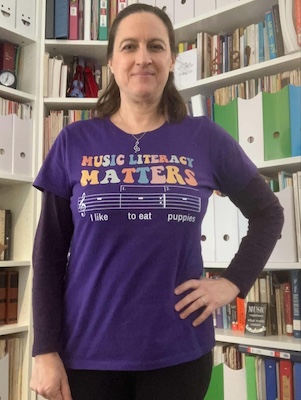
4. Host a Music Education Week
If you’re looking to make a splash in the community, consider hosting a week-long event that celebrates the power of music in your area. You can call this “music education week” or another attention-grabbing name that includes “music” or “arts.” This can be a community-wide celebration where everyone gets involved—and it should not be limited to music students!
As part of your music education week, invite local musicians to perform and ask local radio stations to help promote the event. This is a great way to bring attention to talent in your community. You can also organize a talent show that showcases students or a music and arts fair that gives local studios and teachers a chance to display their work.
Consider at least one unexpected event to draw attention and create a sense of excitement for your celebration. For example, you could host a flash mob in a very visible location and then pass out information about music education week. Flash mobs can happen anywhere, anytime. In this video, watch the audience’s reactions when more than 100 people sing the “Hallelujah Chorus” from Handel’s Messiah at a mall food court.
Work with other groups, teachers, schools and nearby MTNA associations to divide the workload. Remember, no event is too small, and it can always grow and evolve from year to year. Even the Coachella Valley Music and Arts Festival was once a very small, one-day event!
5. Use Technology to Build an Advocacy Campaign
Digital tools and social media offer a unique opportunity to advocate for music. Create a dedicated website or social media page to highlight advocacy work, post articles or simply share resources with others. This also gives you a quick reference or link when you need to have advocacy talking points on hand. For the blog I co-author at creativepianoteacher.com, we include a page set aside for arts advocacy research that teachers and parents can access quickly.
Social media is a great outlet to effect change on specific music topics that are meaningful to you, such as music for social change or music and mental health. Grassroots movements can also promote inclusivity by creating spaces for underrepresented artists in your community. You can use hashtags like #MusicForChange or #WomenInMusic to spread the message and connect with a broader community of like-minded advocates. Videos, infographics and blog posts are all useful methods to share the benefits of music.
6. Establish Music Tourism in Your City
While not every city has the music appeal of large urban locations like Nashville or Austin, your community can become its own kind of destination for music lovers. Creating music tourism requires working with the local government or chamber of commerce but can increase the cultural profile of your area.
Some regions have “trails” for locals to discover places they haven’t found and for out-of-town visitors to connect with community gems. For example, in the Cumberland Valley area of Pennsylvania, there are coffee and chocolate trails to encourage residents and visitors to explore small businesses. Similarly, you could promote a “music trail” highlighting venues, performances, local artists and music-related businesses in your city. Some music trails already exist: in North Carolina, the “Blue Ridge Music Trail” celebrates its musical heritage with specific performances at various mile markers.
Advocate with your city officials for policies that support the creation of music districts or public art spaces. Additionally, consider creating a music map of your town. Include places where music is currently made and celebrate historical music associations. For example, in the Paris suburb of Saint-Germain-en-Laye, the Pâtisserie Grandin used to be frequented by Claude Debussy, who was born just across the street. Though their desserts are enjoyed by locals, many visitors also find their way from the big city to this small patisserie to try “Le Debussy,” a hazelnut cake in honor of the composer. While you might not have a claim to fame quite like Debussy’s favorite dessert shop, every community has a history to uncover and share.
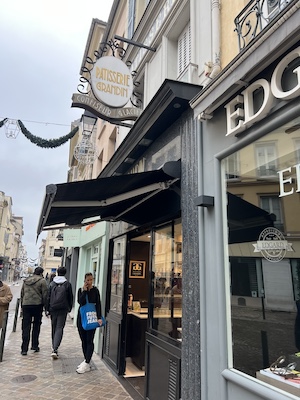
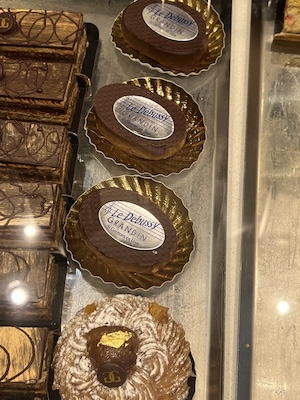
7. Use Music as a Tool for Intercultural Dialogue
Music can bridge divides and create connections between different cultures living in your community. Consider working with non-music groups to host a joint event that highlights diversity and brings together people through music. You can invite musicians from many backgrounds to perform at a festival that celebrates cultural heritage through song and dance.
For example, One World Day is a free event in Cleveland, Ohio, that showcases the city’s diversity through music, dance, food and crafts. There are many different countries represented, and the performances feature traditional artists, giving a space for people of different cultures to engage with each other and celebrate their heritage.
At Messiah University, we have an international gala with performances, traditional clothes, dancing, food and flags from many different countries. It is always a very popular event with limited tickets available, and they often sell out in two hours! Staff member Marcelle Giovanetti says this is one of her “most favorite events” and shared these photos.
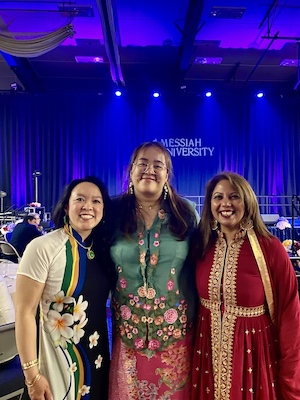
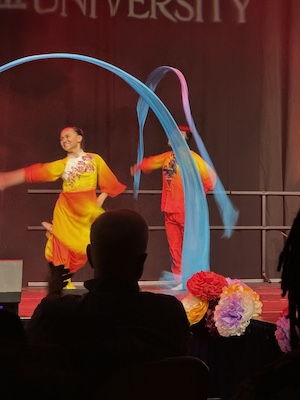
8. Collaborate Across the Arts
There is strength in numbers! Partnering with other arts groups outside of music can amplify advocacy efforts. When programming, consider collaborating with local artists, galleries, dance studios, craftsmen and more. Not only does this build community among artists of all kinds, but it also means a more varied array of attendees will show up to your event simply by broadening the reach.
You can even collaborate with culinary arts! Local restaurants can host music nights, which turn a regular dining experience into a vibrant cultural event. Music can enhance food truck festivals that happen in a central community space. Supper clubs are another trendy venue where music can set the mood. At such an event, you may have business owners or county officials in attendance, and the chef or host may be willing to let you briefly highlight your program to attendees in exchange for providing music.
Striking the Right Chord
Grass roots music advocacy should reflect the unique character of your community. Every location has its own culture, and your advocacy efforts should tap into that. Whether you try one of these ideas or discover something new, the sky is the limit when it comes to creative ways to advocate for music. The most important thing is to create opportunities for others to experience the power of music firsthand and, in doing so, build a sustainable foundation for music programs in your community and beyond.
References
Guhn, Martin, Scott Emerson, and Peter Gouzouasis. 2020. “A Population-Level Analysis of Associations Between School Music Participation and Academic Achievement.” Journal of Educational Psychology, 112 (2): 308–328. https://www.apa.org/pubs/journals/releases/edu-edu0000376.pdf.
Gustafson, Amber. 2017. “The Impact of Music Education on Select Students’ Self-Efficacy.” M.A. Thesis, California State University San Marcos. https://scholarworks.calstate.edu/downloads/s4655h01m.
Hudziak, James, Matthew Albaugh, Simon Ducharme, et al. 2014 “Cortical Thickness Maturation and Duration of Music Training: Health-Promoting Activities Shape Brain Development.” Journal of the American Academy of Child and Adolescent Psychology, 53 (11): 1153–1161. https://www.jaacap.org/article/S0890-8567(14)00578-4/abstract.
Johnson, Christopher and Jenny Memmott. 2006. “Examination of Relationships between Participation in School Music Programs of Differing Quality and Standardized Test Results.” Journal of Research in Music Education, 54 (4): 293. https://eric.ed.gov/?id=EJ773246.
Tierney, Adam, Jennifer Krizman, and Nina Kraus. 2015. “Music Training Alters the Course of Adolescent Auditory Development.” The Proceedings of the National Academy of Sciences (PNAS), 112 (32): 10062-10067. https://doi.org/10.1073/pnas.150511411.

Olivia Ellis, NCTM, is associate professor of music and director of keyboard studies and chamber music at Messiah University. She holds a DMA degree from the University of Oklahoma and co-authors the blog creativepianoteacher.com.